News
The Grand Chocolate Survey 2016
23 March 2016
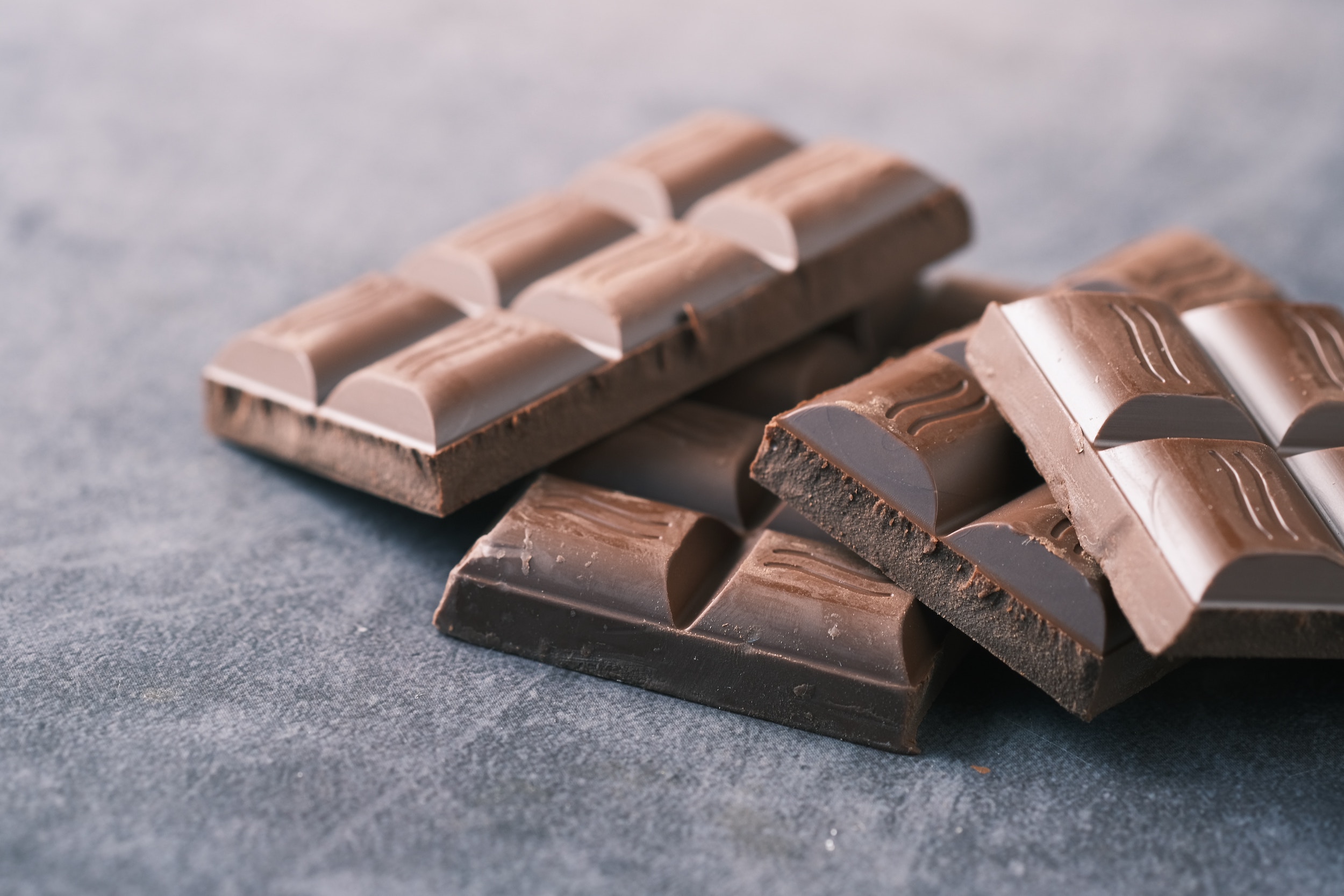
Way back in 2012, we carried out our very first Grand Chocolate Survey, documenting the dimensions, prices and weights of a whole host of the UK’s most popular chocolate bars and sweets. It is testament to people’s enduring love and interest in all things confectionery, that this has consistently been one of our most frequently-read blog articles on the Go Walkabout website over the last 4 years!
As the annual chocolate-fest of Easter is fast approaching, we thought now was a good time to revisit the survey and see what changes have happened in the four years since the last one.
A controversial ‘sugar tax’ in relation to soft drinks with a high sugar content was recently announced in the latest government budget (March 2016) which, will inevitably push up the prices of this kind of product. Sweets and chocolates have so far avoided such a fate, but it will be interesting to see if any other changes are afoot in the future that would affect the prices and sizes of our beloved pocket-sized treats.
There are many reasons for our affordable luxuries becoming both smaller and pricier – including the increasing prices of the raw ingredients, manufacturing costs and also pressure from retailers to make packaging smaller – so they can fit more products onto the shelves. There is also pressure from the government and health organisations to reduce the size of bars to help tackle the rise of obesity and associated health problems.
Have the manufacturers gone too far though, and reduced our favourite sweet treat to a mere shadow of their former selves, and left us wanting more – but paying more for the ‘privilege’ too?
We have now revisited the sweetie aisle and plundered it again for an updated version of our small-scale survey – weighed them, photographed them and compared the results with those recorded in 2012 – with some very interesting results!
The shrinking chocolate bar is not just an urban myth….it’s a reality!
It is an oft-heard gripe that our favourite chocolate treat is getting ever-smaller – but the prices aren’t…. the results of comparing our survey from 2012, and our new one in 2016, seems to show that, yes, several chocolate bars have indeed got quite a lot smaller…
Here are the culprits that are no longer as heavy as they were, four years previously:
| Chocolate Bar | Man. Weight (2016) | Man. Weight (2012) | Reduction in Size (grams) | Tesco Price (2016) | Tesco Price
(2012) |
Manufacturer | % Weight Reduction |
| Boost | 48.5g | 60.5g | – 12g | 60p | 59p | Cadburys | -19.8 |
| Snickers | 48g | 58g | – 10g | 60p | 59p | Mars | -17.2 |
| Yorkie | 46g | 55g | – 9g | 60p | 59p | Nestle | -16.4 |
| Twix | 50g | 58g | – 8g | 60p | 59p | Mars | -13.8 |
| Kit Kat Chunky | 40g | 48g | – 8g | 60p | 59p | Nestle | -16.7 |
| Mars | 51g | 58g | – 7g | 60p | 59p | Mars | -12.1 |
| Double Decker | 54.5g | 60g | – 5.5g | 60p | 59p | Cadburys | -9.2 |
| Galaxy | 42g | 46g | – 4g | 60p | 59p | Mars | -8.7 |
| Munchies | 52g | 55g | – 3g | 60p | 59p | Nestle | -5.5 |
| Lion Bar | 50g | 52g | – 2g | 60p | N/A | Nestle | -3.8 |
Although all of these products have reduced in size, they have all still gone up in price, which doesn’t seem fair, when the consumer is getting less chocolate for their hard-earned cash. Some of the bars have reduced significantly in size, and it is a tad ironic that the heroically -named ‘Boost’ bar has reduced in size by the heftiest amount – perhaps it should be renamed the ‘Shrunk’ bar?!
Perhaps inevitably, none of the chocolate bars or sweets had increased in size, 11 of the survey had remained the same size (although the price hadn’t) and the 10 named above, had decreased in size.
The following bars all reduced in weight by 10% or more:#

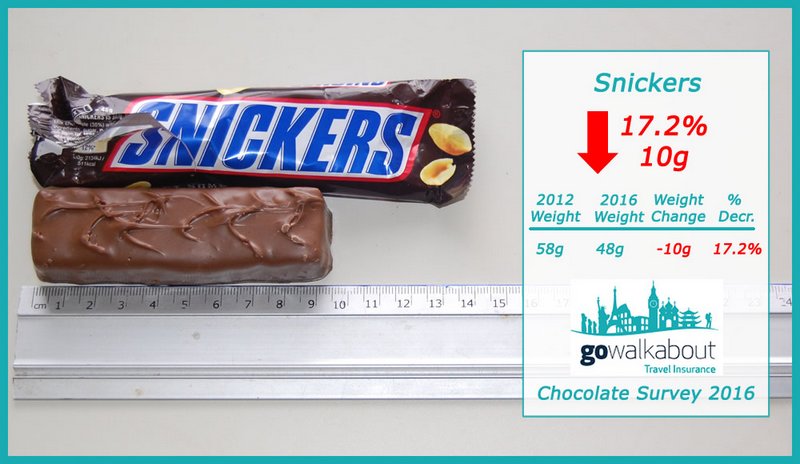
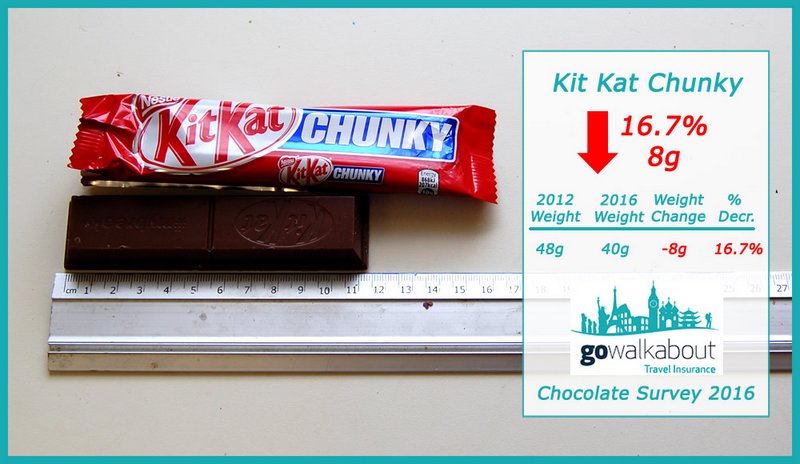
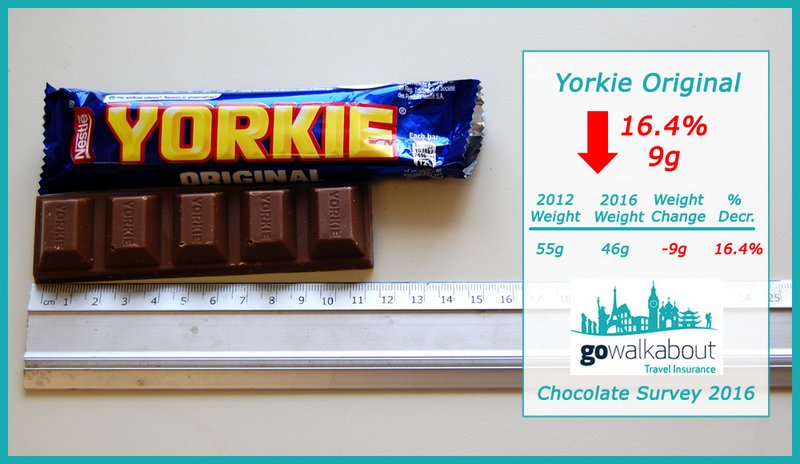
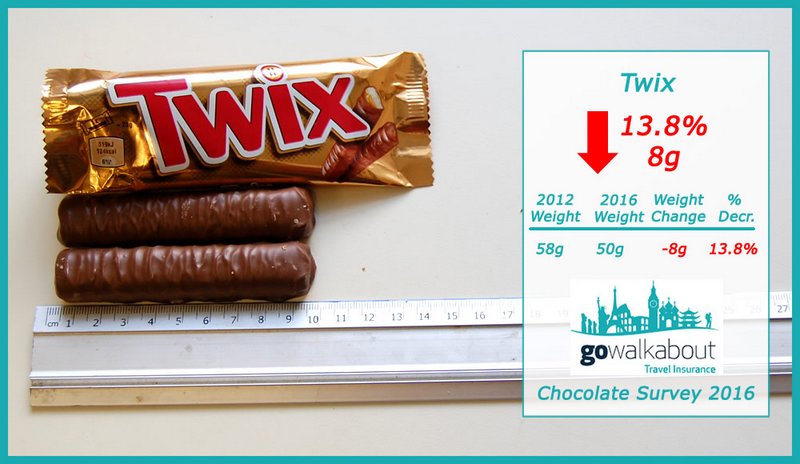

Did the manufacturer’s weight tally with our scales?
It’s one thing to compare the manufacturer’s weights that are declared on the chocolate wrappers, but it’s also interesting to compare the ‘official’ weight, with the weight when we weighed them on our digital scales (taken out of their wrapping) Whilst only a very small-scale survey (we only weighed one of each of the bars), it’s interesting to compare the two, as it may point to a more general trend:
| Chocolate Bar | Manufacturers Weight | Our Weight | Difference |
| Curly Wurly | 26g | 28g | + 2g |
| Peanut M&M’s | 45g | 45g | 0 |
| Skittles | 55g | 56g | +1g |
| 4 bar Kit-Kat | 45g | 45g | 0 |
| Kit Kat Chunky | 40g | 40g | 0 |
| Galaxy | 42g | 42g | 0 |
| Maltesers | 37g | 38g | +1g |
| Mars | 51g | 52g | +1g |
| Wispa | 39g | 40g | +1g |
| Fudge | 25.5g | 25g | -0.5g |
| Dairy Milk | 45g | 46g | +1g |
| Picnic | 48.4g | 46g | -2.4g |
| Lion | 50g | 50g | 0 |
| Crunchie | 40g | 38g | -2g |
| Bounty | 57g | 56g | -1g |
| Minstrels | 42g | 48g | +6g |
| Yorkie | 46g | 46g | 0 |
| Snickers | 48g | 51g | +3g |
| Star Bar | 49g | 49g | 0 |
| Dairy Milk Caramel | 45g | 45g | 0 |
| Choc M&M’s | 45g | 46g | +1g |
| Double Decker | 54.5g | 56g | +1.5g |
| Flake | 32g | 32g | 0 |
| Twix | 50g | 50g | 0 |
| Twirl | 43g | 44g | +1g |
| Milky Bar | 25g | 25g | 0 |
| Toffee Crisp | 38g | 41g | +3g |
| Munchies | 52g | 55g | +3g |
| Boost | 48.5g | 45g | – 3.5g |
| Rolo | 52g | 53g | +1g |
Looking at the table above, it’s clear that there are some bars that were heavier than advertised (46.7%), some were the same (36.6%) and some were lighter than stated on the packet (16.7%) It’s good to see that the majority (83.3%) were either the correct weight, or heavier, and in this case, you certainly got more Minstrels for your money – a whole extra 6g in fact!
Here is the Top 5 of over-weight treats:
1st Minstrels + 6g more than advertised
Joint 2nd Toffee Crisp +3g more than advertised
Munchies
Snickers
3rd Curly Wurly +2g more than advertised
Here is the Roll of Shame for the 5 most under-weight treats:
1st Boost – 3.5g less than advertised
2nd Picnic – 2.4g less than advertised
3rd Crunchie – 2g less than advertised
4th Bounty – 1g less than advertised
5th Fudge – 0.5g less than advertised
It seems like the “Boost” bar is once again failing to live up to the expectations set by its hyperbolic moniker, and I also noticed that 4 out of the 5 bars (excluding Bounty) are made by Cadburys….. I know this is only a very small-scale survey, and we would have to weigh many bars to come up with any kind of scientific conclusion, but really – it isn’t good enough for any bar of chocolate to short-change the consumer.
Cadburys is a famous and long-established British chocolate manufacturer, which was controversially taken over by the American company Mondelez (originally Kraft Foods) in 2010, and many have bemoaned the direction that the company has taken the brand in, since then.
Many in this country still remain loyal to the Cadburys brand though, and it’s obviously very important that the company make sure that their production and checking processes are stringent enough to ensure that customers get what they pay for- not less.
Still pack-ing a punch?
What if you prefer a bag of individual sweet treats, to a bar? How has this twist on the genre fared over the four years since the last survey?
| Number in pack 2012 | Number in pack 2016 | Difference | Colours (if applicatble) 2012 | Colours (if applicable) 2016 | |
| Choco M&M’s | 48 | 53 | + 5 | 11 brown, 9 orange, 8 green, 8 red, 7 yellow, 5 blue | 13 orange, 10 red, 10 brown, 8 green, 7 yellow, 5 blue |
| Skittles | 54 | 50 | – 4 | 18 green, 15 orange, 8 red, 7 purple, 6 yellow | 15 green, 11 yellow, 10 orange, 7 purple, 7 red |
| Peanut M&M’s | 19 | 18 | – 1 | 6 red, 5 orange, 4 blue, 3 brown, 1 green | 5 blue, 3 green, 3 brown, 3 yellow, 2 orange, 2 red |
| Maltesers | 20 | 18 | – 2 | N/A | N/A |
| Munchies | 12 | 12 | 0 | N/A | N/A |
| Rolo | 10 | 10 | 0 | N/A | N/A |
| Minstrels | 16 | 18 | +2 | N/A | N/A |
It’s interesting that two of the packs have bucked the trend of reducing the number of sweets that are included – which are the Choco M&M’s and the Minstrels. The Choco M&M’s have increased quite significantly by a further 5 per packet, and the Minstrels have increased by 2 per pack, which is in stark contrast to Skittles, Peanut M&M’s and Maltesers, who have all downsized. The amount of Munchies and Rolos in a pack, have remained the same – I guess it would be more obvious to remove one of these from the length of a pack, whilst it is easier to take out a couple of smaller sweets, without being so visibly absent.
With reference to the colour combinations, the ratios for the colourful Choco M&M’s, Skittles, and Peanut M&M’s are all different from last time around – this could point to a generally random colour distribution, or that the ratios have changed over time to reflect the popularity of certain colours with consumers? It would clearly take a more extensive sample size to pinpoint this accurately, we’d love to hear your findings from you – if you decide to accept this highly-scientific challenge!
It has been really interesting (albeit a little depressing) to revisit our 2012 chocolate survey, as it has confirmed our suspicions that many of our favourite chocolate bars are indeed shrinking year-on -year. Of course, this knowledge wont deter us from buying a chocolate bar, but it might just make us a bit more discerning about what chocolate bar we choose from the confusing array available.
Another thing that occurred to me in the aftermath of the Survey, as the weighed, measured and counted chocolate bars sat in a carrier bag in a corner of the office – was that it was that my male colleagues (and not women) who were the ones seemingly unable to resist the lure of the bag’s contents and were regularly dipping in for a chocolate hit.
Now, maybe that’s a piece of research for the future…….
Related posts
Hidden Gems Travel Competition Entries
7 March 2013Read more
Places to Visit | Travel Tips | Worldwide TravelA Lille bit of festive fun!
12 December 2017Read more
Company News | CompetitionsWinning Reinventions! Our Travel Writing Competition Results
27 March 2014Read more
Misc | Travel NewsWould you let your child travel without you?
15 April 2013Read more